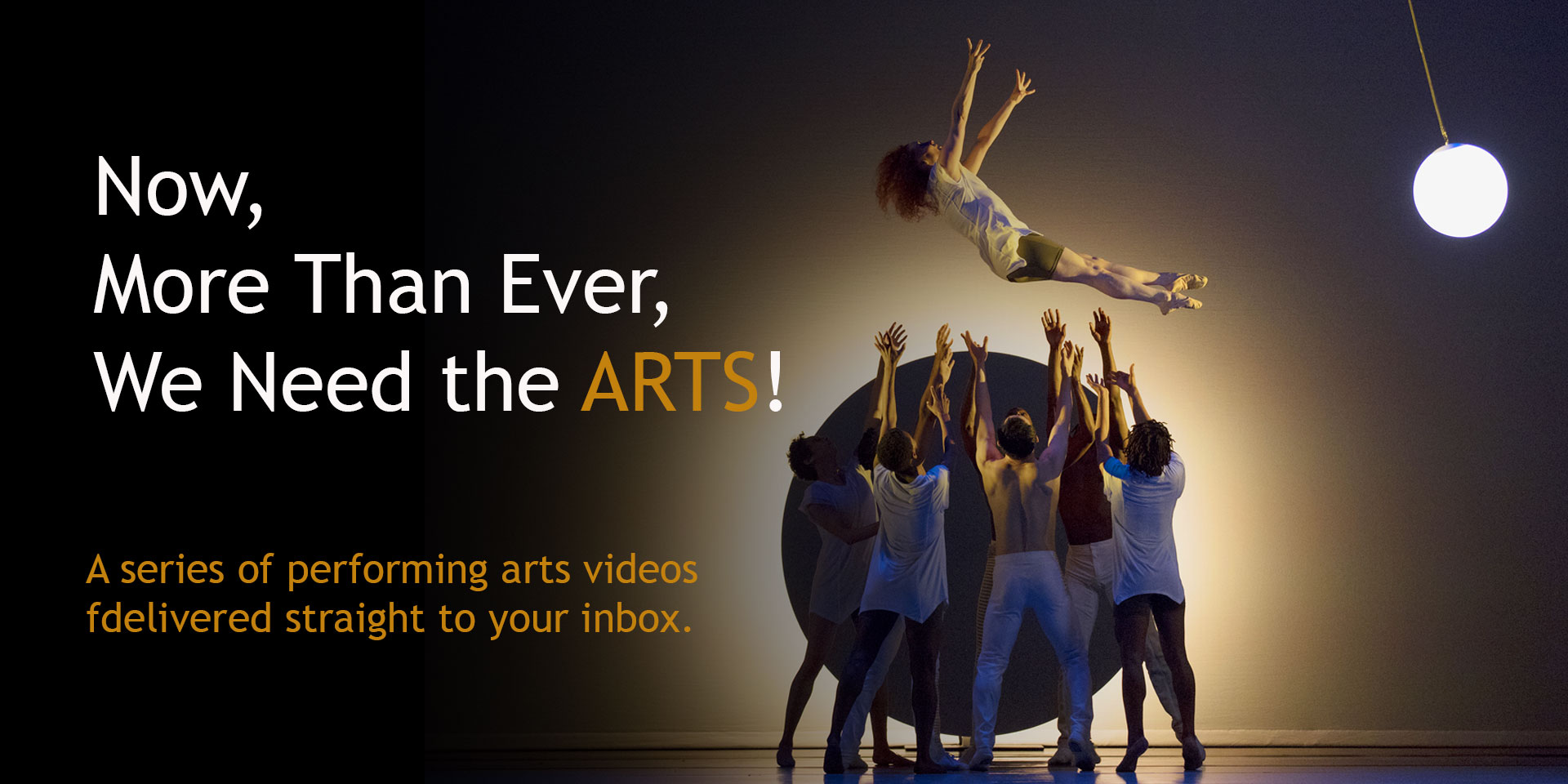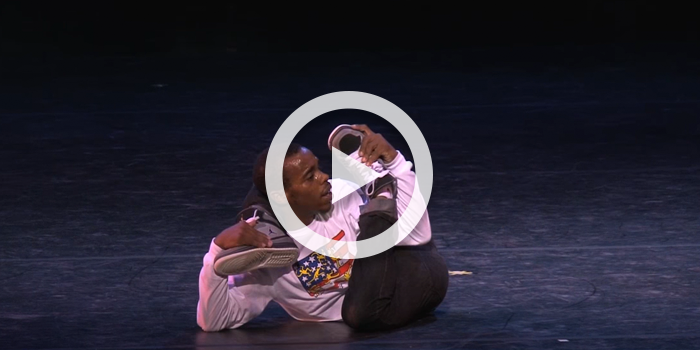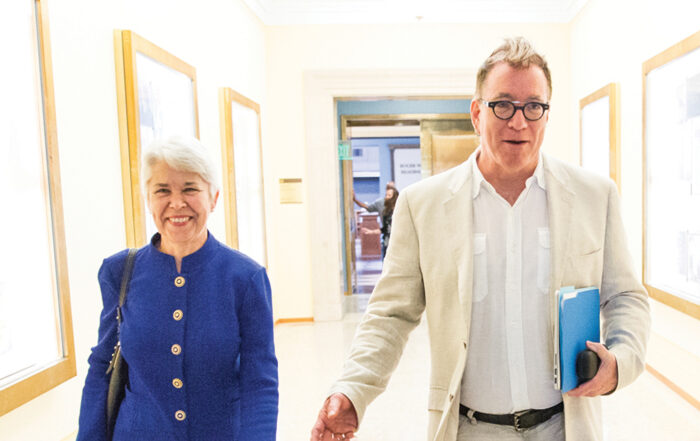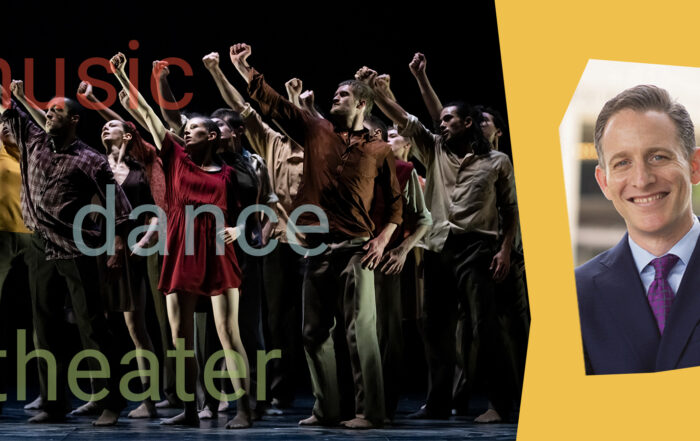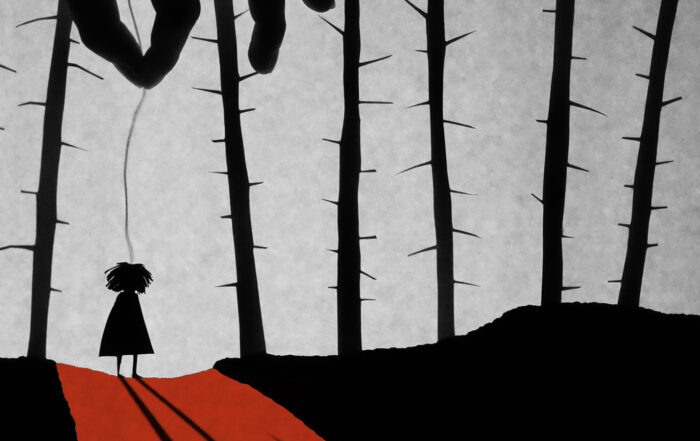A wide variety of performances for everyone, including: In C choreographed and performed by Sasha Waltz; Bartók’s Allegro non troppo from Violin Concerto No. 2 performed by Leonidas Kavakos; Gounod’s “Ô ma lyre immortelle” from Sapho performed by J’Nai Bridges; Kosma/“Autumn Leaves” performed by Gonzalo Rubalcaba Trio
Now, More Than Ever
Celebrating great performances, past and present.
As a light begins to shine on the horizon and we move toward recovery from the current pandemic, Cal Performances joins our entire audience in looking forward to a return to live presentations in our UC Berkeley concert halls. Surely, that day can’t arrive soon enough!
Since March 2020, and through the pandemic’s darkest days, Now, More Than Ever has continued to celebrate the performing arts’ unsurpassed ability to express the strength and resilience of the human spirit. Through these blog posts, we have enjoyed upwards of 300 memorable performances by the world’s most accomplished and inspiring artists.
Cal Performances hopes you’ll continue to enjoy these YouTube-led virtual journeys—presentations designed specifically for our adventurous and eclectic audiences—until, that is, we can share such experiences together again, live, and under the same roof.
Most importantly, we continue to encourage one and all to find time—each and every day—for the performing arts!
Curated by Jeremy Geffen, Executive and Artistic Director, Cal Performances
Now, More Than Ever: Issue 57
Today’s column is not built around an overarching theme or idea, but rather honors our desire to feature a wide variety of artists whose work can act as a reminder of the immense power of the performing arts. We’ll look at a thrilling contemporary reconsideration of a classic work of minimal music (with one brilliant artist paying tribute to another), a riveting meeting of the minds between composer and instrumentalist by way of a rich helping of 20th-century orchestral music, a captivating delivery of a wonderful 19th-century opera aria from one of today’s most gifted young mezzo-sopranos, a jaw-dropping and original take on the classic song “Autumn Leaves,” and a fierce vocal performance by a woman who was among the most famous and infamous singers of her time. Today, Now, More Than Ever serves up something for everyone!
In C
Choreography by Sasha Waltz
Music by Terry Riley
Sasha Waltz & Guests
There’s so much I could say about Terry Riley’s In C (1964), the first undisputed masterpiece of minimal music, but for now, I’ll focus on the work’s intentional ephemerality. A totally modular piece that is meant never to be performed the same way twice—with countless decisions left to the musicians who themselves can be arranged in any configuration imaginable—In C, in meaningful ways, only truly exists on the two pages on which it is written. Anything else—any performance by any number of players—is simply a temporary “impression” of the music itself.
The revered German choreographer Sasha Waltz (a favorite and frequent visitor to Zellerbach Hall) covers all of this much more capably in her spoken introduction to her company’s new version of In C, which was streamed live to international audiences last weekend. For this moving and timely project, Waltz brilliantly developed an original choreographic language that meets Riley’s music on its own modular terms, while simultaneously expanding her exploration to include the dimension of space.
Before watching the performance, I encourage you to first listen to Waltz’s introductory remarks (from 3:35 to 6:49). Then, and in the spirit of both the music and the dance, drag your finger across the timing bar on your screen to select—at random—a moment at which to start watching. Begin by viewing just 10 minutes of this nearly hour-long work. Then, if you have the time, watch it in its entirety, from the beginning. I think you’ll want to!
What a celebration of the spontaneous act of artistic creation! I suspect we may never see a production like this again, for what we have here is a true pandemic performance. In every way, it honors the essence of Terry Riley’s great In C.
Please note that, in my experience, videos of performances like this often have a short shelf-life and disappear quickly from streaming services. I hope that doesn’t occur with this remarkable film, but my suggestion is that you watch it—in part or in full—as soon as possible.
Bartók: Allegro non troppo
from Violin Concerto No. 2
Leonidas Kavakos, violin
Berliner Philharmoniker
Sir Simon Rattle, conductor
(This selection, the concerto’s first movement, ends at 16:45.)
Among the most naturally talented violinists I know, Leonidas Kavakos is something of a marvel, handling the violin so easily while making everything look simple! Physically, he’s built rather unusually for the violin, so tall that the instrument looks tiny in his hands. Add to that, he plays with an apparent absence of physical tension that perfectly reflects his own very natural musicianship. Kavakos has a big sound, but what makes it attractive is that it’s at once large and unforced. And I can think of few pieces of music that better showcase his singular talent than this grand concerto by Béla Bartók.
Written just before the composer immigrated to the US, the work premiered at Amsterdam’s Concertgebouw in 1939 with Bartók’s friend Zoltán Székely (for whom it was composed) as soloist and Willem Mengelberg conducting. It begins almost like a strummed guitar (by the harp, against the low strings’ gentle pizzicato), but then opens into a simple melody, sounding almost like a folk song and reminding us that by this period, Bartók had so internalized the sounds of folk music that he could create original material that sounds traditional but has no original source other than his own creativity. If there is a short list of compositions that are—to all intents and purposes—perfect, I think the first movement of this concerto is an example, everything in ideal proportion.
Early in Kavakos’ career, some dismissed him as a showman. That criticism has long since been dispelled, due in large part to performances like this. Here he truly lets you in, finding vulnerability and depth where others would merely encounter a challenge.
For comparison, check out this clip of a young Kavakos playing Paganini’s devilishly demanding Caprice No. 5. Let’s be honest; this work should probably never be played this fast. (The human ear just can’t take in all the notes.) But still, it’s quite a dazzling accomplishment!
Gounod: “Ô ma lyre immortelle” from Sapho
J’Nai Bridges, mezzo-soprano
BBC National Orchestra of Wales
Thomas Søndergård, conductor
If time has not been a friend to Charles Gounod’s Sapho—indeed, the opera did not receive its American professional premiere until 2018—the work’s final aria, “Ô ma lyre immortelle,” has managed to carve out a life of its own, receiving fine recordings by the likes of Grace Bumbry, Shirley Verrett, and Marilyn Horne.
For my part, and speaking generally, I must admit that I have no great affection for Gounod’s music, with the exception of this and a handful of other works. The reason I wanted to feature this video today is because of J’Nai Bridges, a compelling newcomer (she made her Met debut just two years ago) who is now attracting quite a lot of attention on the international opera scene. Already familiar to San Francisco Opera audiences (Carmen; Girls of the Golden West), Bridges commands an exquisite voice, with stage presence and statuesque beauty to match. I was very excited to see that she will be featured in a San Francisco Opera virtual performance that will go live this week!
The aria may be a bit of “ear candy,” but whenever you hear a performance this convincing, it’s not hard to set aside any resistance.
Where am I?
Ah! yes, I remember.
All that bound me to life is broken.
All that remains for me is eternal darkness,
Where my heart, exhausted by grief, can rest.
Oh my immortal lyre,
Who, during sad times,
Faithful to all my sorrows,
Always consoled them.
In vain thy sweet murmur
Tries to help me in my suffering.
No, thou canst not heal
My final wound,
My wound is to the heart.
Only death can put an end to my pain.
Farewell, torch of the world.
Sink beneath the waves.
I sink into the deep
Into eternal rest.
The new day that will dawn,
Phaon, will shine for you,
But with no thought of me
Thou wilt see another dawn.
Open up, bitter abyss.
I go to sleep forever in the sea.
Kosma/“Autumn Leaves”
Gonzalo Rubalcaba Trio
Gonzalo Rubalcaba, piano
John Patitucci, bass
Jack DeJohnette, drums
Since 1950, when Yves Montand first brought fame to Joseph Kosma’s “Autumn Leaves” (1945), upwards of 1,400 cover versions have made it one of the most-recorded songs in history. The famous tune may be almost unrecognizable in this version—so refined is the interpretation—but the real news here is the spectacular virtuosity of Gonzalo Rubalcaba, John Patitucci, and Jack DeJohnette.
Patitucci plucks his solo at a speed I would have thought impossible on the double bass. Rubalcaba is voracious: here inserting double octaves as though they’re child’s play; there bringing in the rhythms of his native Cuba as if they were always part of this song. In the audience, appearing as gob-smacked as I was when I happened upon this video, we see Dianne Reeves and the late Chick Corea. Captured live at the 1991 Mount Fuji Jazz Festival, this sizzling and virtuosic performance finds three perfectly matched collaborators using a classic tune as a point of departure, the genius of their improvisations taking place actually within and between the bars of “Autumn Leaves.”
E. Fabregat: “Soledad”
Chavela Vargas, vocals
When the legendary Chavela Vargas passed away in 2012, the UK’s Guardian led its obituary:
Gut-wrenching renditions of Mexican popular classics combined with a taboo-breaking personality and an iron liver ensured that Chavela Vargas, who has died aged 93, lived her own legend to the full. Vargas’s raw, rasping voice and intimate arrangements stripped down well-known rancheras, boleros, revolutionary ballads and tangos to leave them as haunting laments, punctuated by waves of tenderness and bitter irony.
We’ll probably never know the full truth of all the rumors and stories—the torrid affair with Frida Kahlo, the seduction of numerous Hollywood celebrities (including Ava Gardner at one of Elizabeth Taylor’s weddings!). Vargas herself usually protected her partners’ identities. But the art will always be there, full, untamed, and raw.
I love that, in the 1990s, the renowned Spanish filmmaker Pedro Almodóvar featured Vargas in some of his best work, helping to ensure a late-in-life “second wind” for the singer that attracted capacity crowds to the world’s most famous concert halls. “Chavela Vargas turned abandon and desolation into a cathedral within which we all fit,” Almodóvar wrote following her death. “She emerged reconciled with the errors she had made and ready to make them again.”
Here’s a clip from Almodóvar’s La flor de mi secreto (The Flower of My Secret), featuring the marvelous Marisa Paredes. At wits’ end (she has truly reached rock bottom!), Paredes watches on television a popular “screaming contest” in Madrid, and then Vargas singing her hit “El Último Trago,” whose lyrics include: “The years haven’t taught me anything. I always keep making the same mistakes. Once again I’ll drink with strangers. And cry from the same pain.”).
Soledad…
It was a starless night
when departing from me you left me
so much pain and so much evil.
Soledad…
Since the day you left
in the village there’s only
conventual silence.
Soledad…
The streams are dry
and in the streets a thousand echoes
call you night and day.
Soledad… come back now
to take away your songs.
The crepe, which casts a shadow
over my loneliness, will stay forever.
Soledad… come back now…
And it comes back now… my loneliness…
Now, More Than Ever Full Playlist
Now, More Than Ever Spotify Playlist


